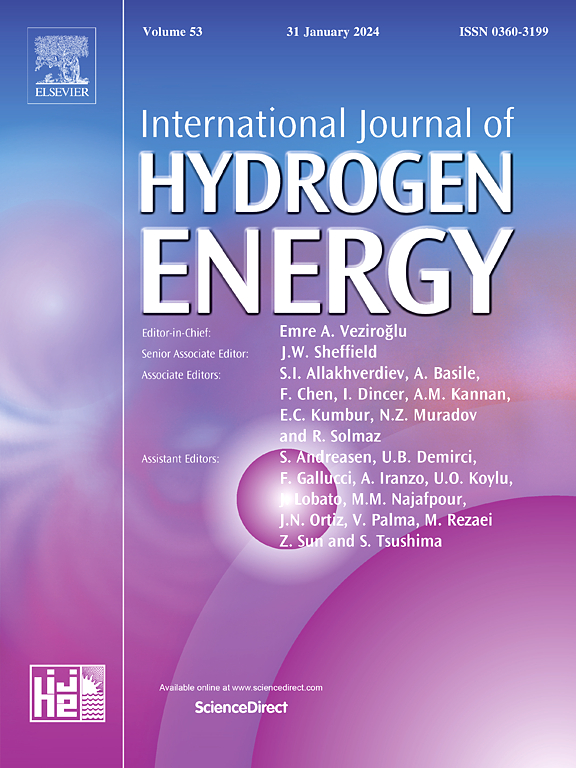Platinum-palladium catalysts of various composition in the oxygen electroreduction reaction
IF 8.1
2区 工程技术
Q1 CHEMISTRY, PHYSICAL
引用次数: 0
Abstract
PtxPd/C (x = 3.5, 2.1, 1.4) catalysts with varying compositions and a metal loading of approximately 40 wt% were synthesized using sequential reduction of palladium and platinum precursors in the liquid phase. Their structural, morphological characteristics, and electrochemical behavior in the oxygen reduction reaction (ORR) were investigated. Standardized platinum-palladium catalysts demonstrated a higher electrochemically active surface area (ECSA) and mass activity in ORR compared to a conventional Pt/C catalyst (HiSpec4000, Johnson Matthey). Among the synthesized catalysts, the Pt3·5 Pd/C composition retained the highest ECSA and mass activity after stress testing in a three-electrode cell. Membrane-electrode assemblies of hydrogen-air fuel cells based on Pt2·1 Pd/C and Pt3·5 Pd/C demonstrated practically comparable performance to the MEA based on the conventional Pt/C catalyst. The study revealed that:i) The influence of the platinum-to-palladium ratio in the catalysts on their properties is determined by a combination of factors, including the structural and morphological characteristics of the metal-carbon nanocomposites, the architecture of bimetallic nanoparticles, and the fraction of nanoparticles with optimal microstructure in each synthesized sample; ii) Platinum-palladium electrocatalysts at the cathode of a proton-exchange membrane fuel cell exhibit comparable performance to the Pt/C analogue.

氧电还原反应中不同组成的铂钯催化剂
通过液相中钯和铂前驱体的顺序还原,合成了不同成分的PtxPd/C (x = 3.5, 2.1, 1.4)催化剂,其金属负载约为40 wt%。研究了它们的结构、形态特征和氧还原反应(ORR)中的电化学行为。与传统Pt/C催化剂(HiSpec4000, Johnson Matthey)相比,标准化铂钯催化剂在ORR中具有更高的电化学活性表面积(ECSA)和质量活性。在所合成的催化剂中,Pt3·5 Pd/C组成在三电极电池中进行应力测试后,ECSA和质量活性最高。基于Pt2·1 Pd/C和Pt3·5 Pd/C的氢-空气燃料电池膜电极组件的性能与基于传统Pt/C催化剂的MEA几乎相当。研究表明:i)催化剂中铂钯比对催化剂性能的影响是由多种因素共同决定的,包括金属-碳纳米复合材料的结构和形态特征、双金属纳米颗粒的结构以及每个合成样品中具有最佳微观结构的纳米颗粒的比例;ii)质子交换膜燃料电池阴极的铂钯电催化剂表现出与铂/碳类似物相当的性能。
本文章由计算机程序翻译,如有差异,请以英文原文为准。
求助全文
约1分钟内获得全文
求助全文
来源期刊

International Journal of Hydrogen Energy
工程技术-环境科学
CiteScore
13.50
自引率
25.00%
发文量
3502
审稿时长
60 days
期刊介绍:
The objective of the International Journal of Hydrogen Energy is to facilitate the exchange of new ideas, technological advancements, and research findings in the field of Hydrogen Energy among scientists and engineers worldwide. This journal showcases original research, both analytical and experimental, covering various aspects of Hydrogen Energy. These include production, storage, transmission, utilization, enabling technologies, environmental impact, economic considerations, and global perspectives on hydrogen and its carriers such as NH3, CH4, alcohols, etc.
The utilization aspect encompasses various methods such as thermochemical (combustion), photochemical, electrochemical (fuel cells), and nuclear conversion of hydrogen, hydrogen isotopes, and hydrogen carriers into thermal, mechanical, and electrical energies. The applications of these energies can be found in transportation (including aerospace), industrial, commercial, and residential sectors.
 求助内容:
求助内容: 应助结果提醒方式:
应助结果提醒方式:


